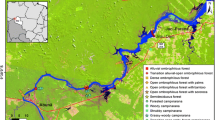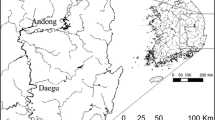Abstract
A fragile plant cover has developed during the last two decades along the shores of Lake Nasser, the largest impoundment of the River Nile. Development of this vegetation has been influenced by the prevailing environmental factors. The statistical methods (ordination and classification techniques) emphasise the groups of species and elucidate their distribution within the environmental gradients. The applied methods indicate that the distribution of the species is strongly related to the moisture gradient. Some of the soil parameters also contribute to the gradient. The geographical gradient in the distribution of the species is less pronounced.
Similar content being viewed by others
References
Abdel-Razik, M., Abdel-Aziz, M. & Ayyad, M. 1984. Multivariate analysis of vegetational variation in different habitats of Omayed, Egypt. Vegetatio 57: 167–175.
Abu-Zeid, M. 1987. Environmental Impact Assessment for the Aswan High Dam. In: Environmental impact assessment for developing countries ETA. Edited by A. K. Biswas and Qu Geping, The United Nations University, Publ. by Tycooly International, London: 168–190.
Ayyad, M. A. & Dix, R. L. 1964. An analysis of a vegetation-microenvironment complex of prairie slopes in Saskatchewan. Ecol. Monogr. 34: 421–442.
Briggs, J. & Dickinson G. 1988. Casting seed upon the wadi. Geogr. Mag., March: 30–31.
El-Hadidi, M. N. 1976. The riverain flora in Nubia. In: The Nile, biology of an ancient river. Edited by J. Rzoska. Dr W. Junk, The Hague: 103–109.
Entz, B. 1976. Lake Nasser and Lake Nubia. In: The Nile, biology of an ancient river. Edited by J. Rzoska. Dr W. Junk, The Hague: 271–298.
Entz, B. 1980. Ecological aspects of Lake Nasser-Nubia. Water Supply & Management 4: 67–72.
Fénélon, J. P. 1981. Qu'est que l'Analyse des Donnees? Lefonen, Paris.
Hill, M. O. 1974. Correspondence analysis: A neglected multivariate method. Journal of the Royal Statistical Society, Series C 23: 340–54.
Murphy, K. J., Roslett, B. & Springuel, I. 1990. Strategy analysis of submerged Lake macrophyte communities: an international example. Aquatic Botany 36: 303–323.
Raheja, P. C. 1973. Man-Made Lakes. Their problems and environmental effects. American Geophysical Union, Washington, D.C. Geophysical Monograph 17: 234–240.
Roux, M. 1989. BIOMECO 3.51, Logiciel d'analyse de données CEPE/CNRS, Montpellier.
Springuel, I. 1985. Study on shoreline vegetation of High Dam Lake at Aswan, Egypt. Asw. Sci. Tech. Bull. 6: 297–315.
Springuel, I. 1987. Plant life in Nubia. V. Aquatic plants in Egyptian Nubia. Asw. Sc. Tech. Bull. 8: 185–221.
Springuel, I., Ali, M. M. & Murphy, K. J. 1990. Aquatic macrophyte growth in relation to water level regime in the River Nile and its impoundments in Upper Egypt. Proceeding EWRS 8th Symposium on Aquatic weeds, Uppsala: 199–201.
Zahran, M. A., El-Demerdash, M. A. & Mashaly, I. A. 1990. Vegetation types of the deltaic Mediterranean coast of Egypt and their environment. Journal of Vegetation Science 1: 305–310.
Additional information
Botany Department, Faculty of Science in Aswan, Assiut University
Botany Department, Faculty of Science, Cairo University
Rights and permissions
About this article
Cite this article
Springuel, I., El-Hadidi, N.M. & Ali, M.M. Vegetation gradient on the shores of Lake Nasser in Egypt. Vegetatio 94, 15–23 (1991). https://doi.org/10.1007/BF00044912
Accepted:
Issue Date:
DOI: https://doi.org/10.1007/BF00044912




